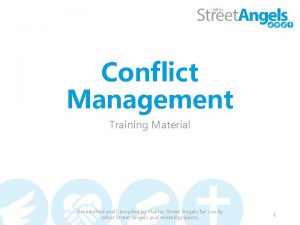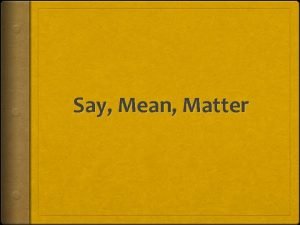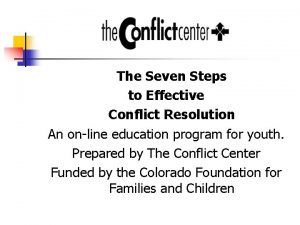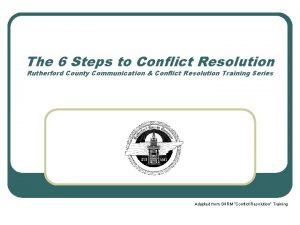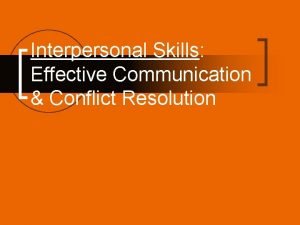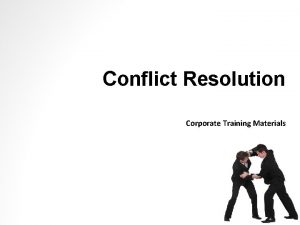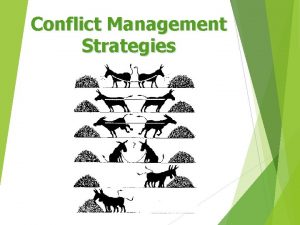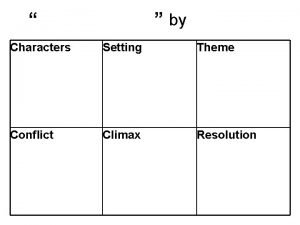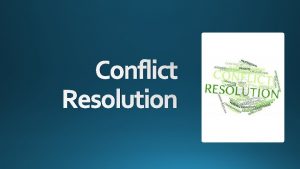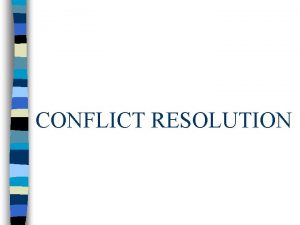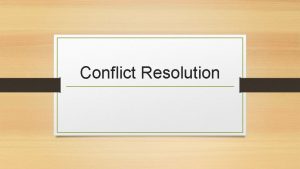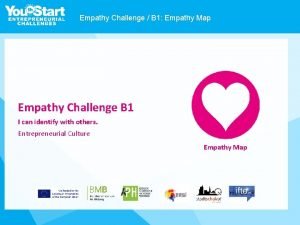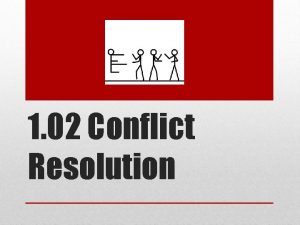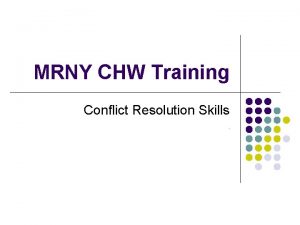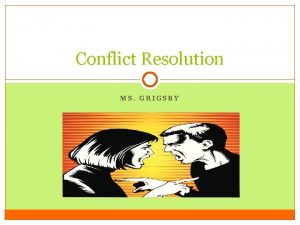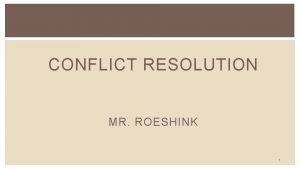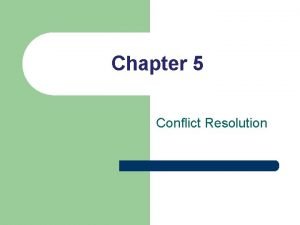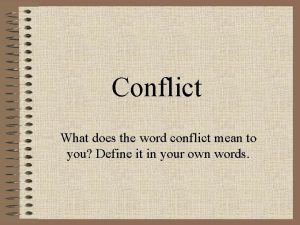Conflict Resolution Empathy Empathy What does empathy mean
























- Slides: 24

Conflict Resolution Empathy

Empathy § What does empathy mean? § Empathy is “feeling into”, seeing how it is through another's eyes. § It involves experiencing the feelings of another without losing ones own identity.

Empathy § The emphatic person senses the other person’s bewilderment, anger, fear or love “as if” it were his own feeling, but he does not lose the “as if” nature of his own involvement. (Robert Bolton, People Skills, 1987)

Empathy § Some of the things that help you to feel empathy towards another person are: § Trust § Attentiveness § Appropriate Responses § Shared Experiences § Respect § Support

Empathy § Some of the things that make it difficult to feel empathy towards another person are: § Inattentiveness § Lack of interest § Lack of respect

Empathy § The key elements of empathy as a skill are: § We must separate our responses from those of § § § the person we are empathizing. Retain objectivity and distance Be alert to cues about feelings offered to us by the other person. Communicate to people our feeling for them and our understanding of their situations.

Empathy § Some things a person can do to help in the § § § communication process are: Stop talking. Always remember that if you are talking, than you are not listening. Ask questions Using “mms” and “ahs” to encourage them. Maintain good eye contact. Display attentive and welcoming body language.

Empathy § Some things a person can do to shut down the communication process are: § Not really listen § Not showing interest § Not being attentive to the person speaking § Poor eye contact § Changing the topic

Empathy § When attempting to empathize with someone you must always be on the watch for empathy blockers. There are four main types: § Domination § Manipulation § Disempowerment § Denial

Empathy § § § Domination Threatening: “Do it or else” Ordering: “Don’t ask me why, just do it because I said so” Criticizing: “You don’t work hard enough”; “You’re always complaining” Name-Calling: “Only an idiot would say that”; “You’re neurotic” Shoulding or oughting: “You shouldn’t be so angry”; “You ought to face facts”

Empathy § § § Manipulation Withholding Relevant Information: “If you knew the “big picture” you would see it differently” Interrogating (micro-managing): “How many hours did this take you? ” “What are you doing now? ” Praising to manipulate: “You are so good at report writing, I would like you do this one. ”

Empathy § § § Disempowerment Diagnosing motives: “You are very possessive”; “You have always had a problem with time management” Untimely advice: “Why didn’t you do it this way? ” Changing the topic: “Yes it is a worry…by the way, did I tell you I applied for a new job? ” Persuading with logic: “There’s nothing to be upset about. It’s all quite reasonable…we just do this…than we do that…” Topping: “I crashed the car last week” and you follow with “When I smashed up my car…”

Empathy Denial § Refusing to address the issue: “There is nothing to discuss as I cannot see any problem. ” § Reassuring: “Don’t be nervous”; “Don’t worry it will work out”; “You will be fine”

Empathy Important § Always remember that people in trouble want to be reassured and we want to give that reassurance. § However the “there, everything will be alright” approach is not a help. It may actually be a disservice as everything may not be alright.

Empathy Important § The kind of reassurance that people in difficulty need is not meaningless comfort that the problem will take care of itself, but rather our statement of faith that they will be strong enough to work it out even if it is not alright. § Let them know that you are available and would work with them in finding something that can help.

Empathy § Some of the consequences of using “empathy § § § Blockers” are: Defensiveness, resistance and resentment. Blocks feelings Diminishes self-esteem Decreases the ability to solve problems Creates emotional barriers between people.

Empathy § People tend to fall into the trap of using empathy blockers in many situations, including: § They might be under stress § Feeling angry § Frustrated § Out of control § Out of habit

Empathy § With awareness of our use of empathy blockers we can try to choose more effective methods of communication.

Empathy § When we use an empathy blocker, or shut down our communication when an empathy blocker is used on us, we are probably relying on a habitual and automatic way of behaving that we learned in childhood. § In other words “We React”.

Empathy § However, when we pause a moment and choose a response that opens rather than closes communication, then we can “respond”. You may use phrases such as “I’m listening”, “this really seems important to you” or “let’s discuss it”. § By choosing to respond, we are taking control of our behavior and opening the door to richer relationships.

Empathy § Once we are responding rather than reacting , there can be times when offering assurances or giving advice can be helpful. Those times come after you have listened and others know they have been heard, and after you have shown them respect and recognized how they are feeling.

Empathy § Reassurance and advice may then be given in a cautious, constructive and supportive manner that empowers them to do what they need to in order to move on.

Credits § We wish to thank the Conflict Resolution Network for their generous donation of materials used in the creation of this presentation. § Conflict Resolution Network PO Box 1016, Chatswood NSW 2057 Phone: +61 (0)2 9419 -8500 Fax: +61 (0)2 9413 -1148 Email: crn@crnhq. org Website: www. crnhq. org

Credits § This course was created by AMFA Local 11 to assist in the education of its Professional Standards Committee members. § Permission to use this material is granted to any AMFA Local. § This course was created using materials provided by The Conflict Resolution Network. Permission has been extended to use this material providing credit remains intact on all modules.
 What is conflict and conflict resolution?
What is conflict and conflict resolution? What does cudsa stand for
What does cudsa stand for Defusing conflict palms
Defusing conflict palms High resolution low resolution
High resolution low resolution How to find mean absolute deviation
How to find mean absolute deviation What does mean mean
What does mean mean Say/mean/matter
Say/mean/matter Work ethics for work immersion
Work ethics for work immersion What are the 7 steps in conflict resolution
What are the 7 steps in conflict resolution Six steps of conflict resolution
Six steps of conflict resolution Conflict resolution customer service
Conflict resolution customer service Accountability in conflict resolution
Accountability in conflict resolution Conflict resolution outline
Conflict resolution outline Conflict resolution skills
Conflict resolution skills Conflict resolution training materials
Conflict resolution training materials Conflict resolution exercise
Conflict resolution exercise Scope of conflict resolution
Scope of conflict resolution Steps in the mediation process
Steps in the mediation process Center for african peace and conflict resolution
Center for african peace and conflict resolution Conflict climax resolution
Conflict climax resolution Where is the necklace setting
Where is the necklace setting Staben conflict resolution
Staben conflict resolution Example of a win win situation
Example of a win win situation Watch mastering conflict management and resolution at work
Watch mastering conflict management and resolution at work Write these down
Write these down


